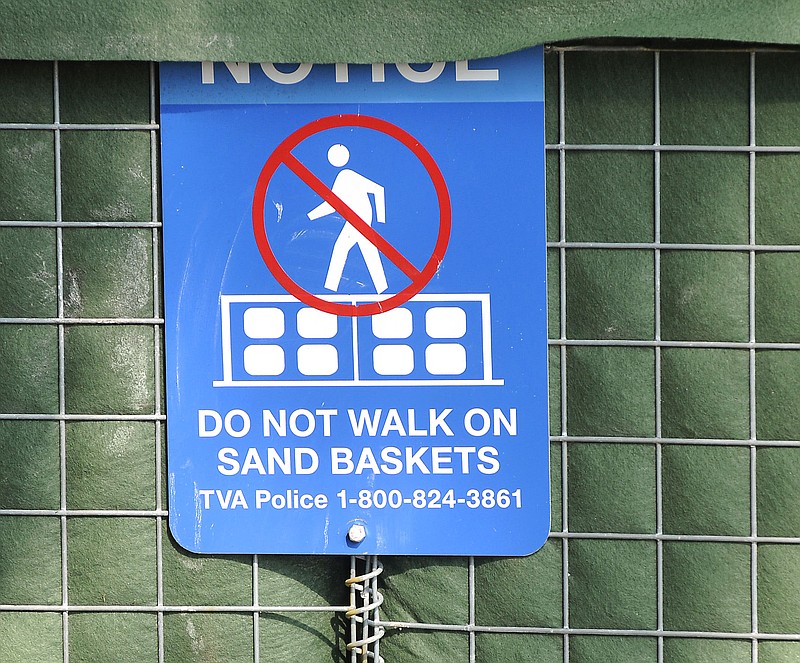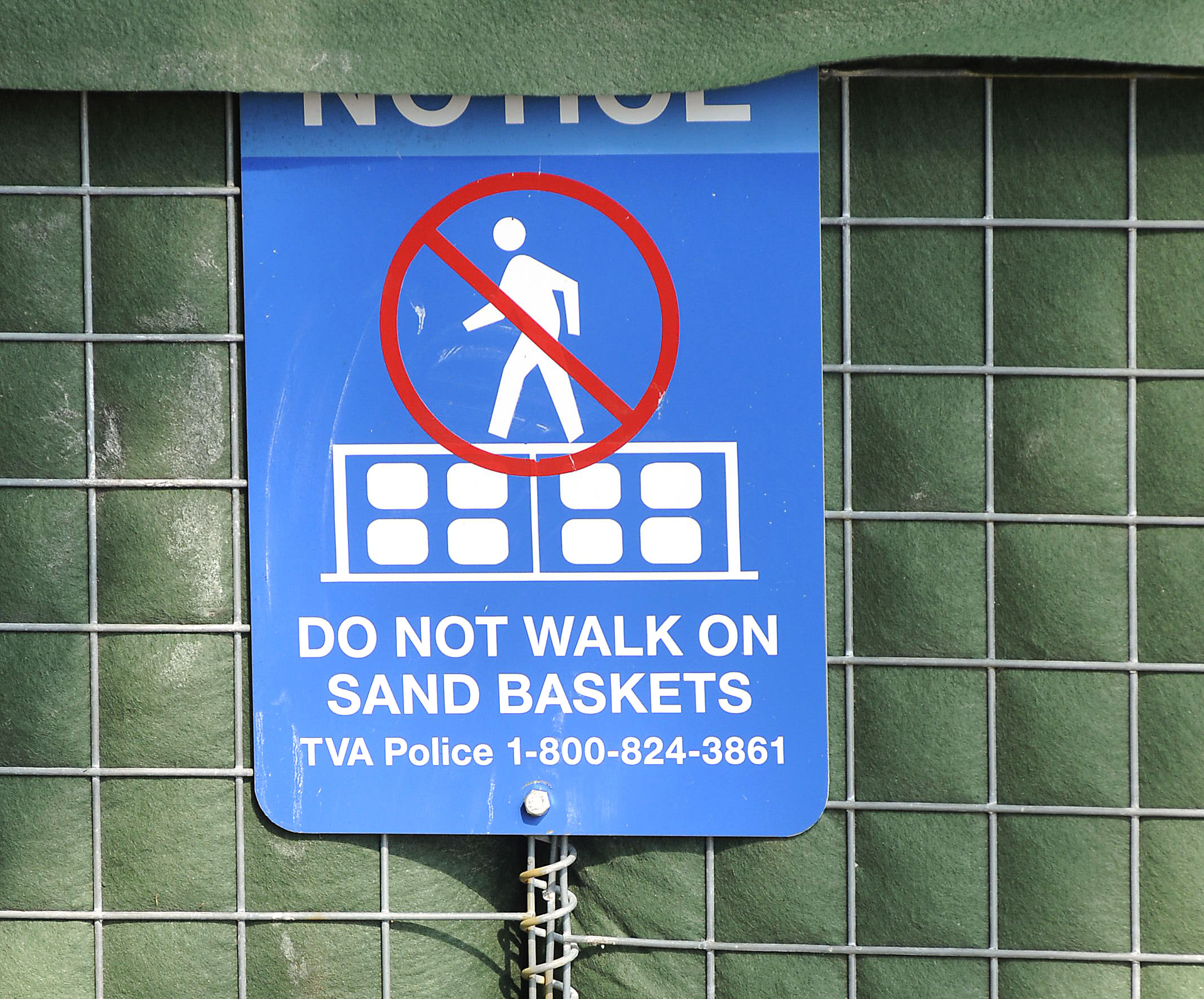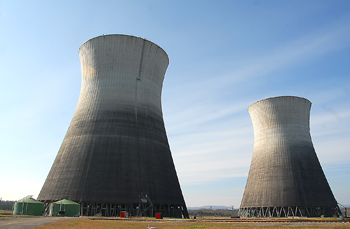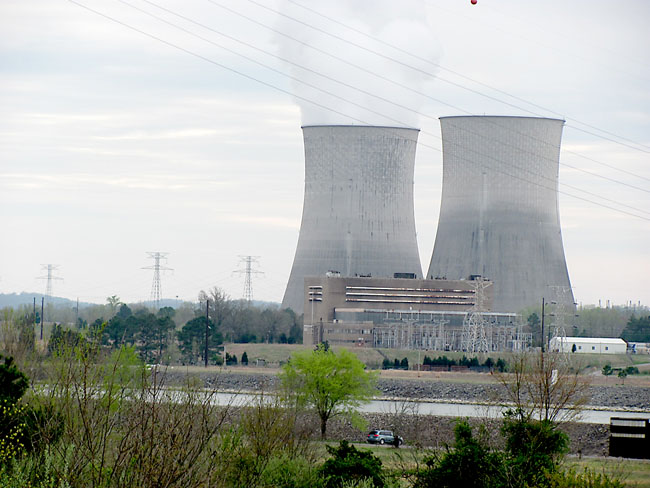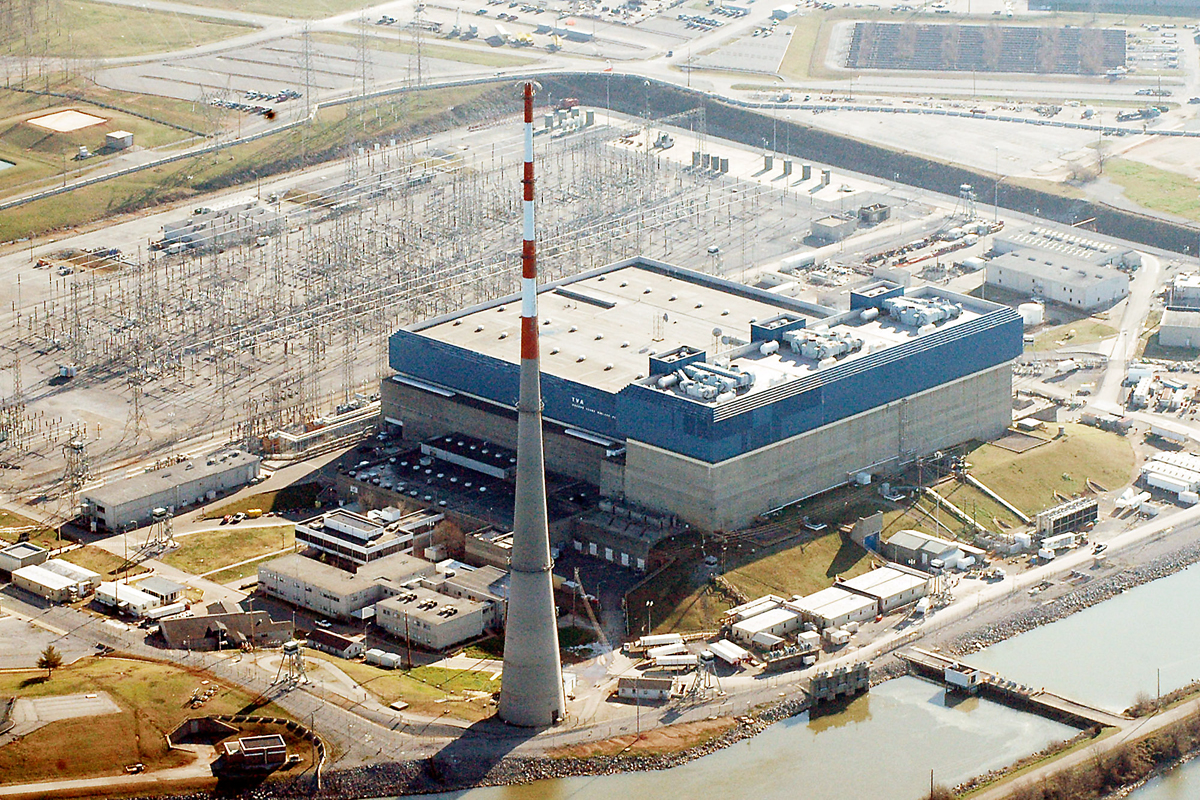PROBABLE MAXIMUM FLOODA "probable maximum flood" is the result of the most severe and reasonably possible combination of rainstorm, snow accumulation, melt rate and ground saturation in a particular drainage area. Dams, reservoirs and other heavy hydraulic structures must be designed to withstand such an event.DAM MODIFICATIONSTVA has raised the height of earthen embankments around four dams by 3 to 4 feet. The length of the embankments around the dams varies by site.• Cherokee: 7,000 feet, up 3 feet• Fort Loudoun: 4,000 feet, up 4 feet• Tellico: 6,000 feet, up 4 feet• Watts Bar: 1,400 feet, up 3 feetSource: TVA
Sand baskets installed to protect against extreme flooding and protect nuclear plants at Watts Bar and three other TVA dams have upstream neighbors unhappy about their new views.
But the safety vs. beauty question - prompted by a decades-old mistaken calculation by TVA - may mean even more dams must be raised with sandbags or permanent fixes, according to the Tennessee Valley Authority and the Nuclear Regulatory Commission.
"We had to fix the problem by raising the embankments as soon as we could or possibly have to shut down [Watts Bar and Sequoyah nuclear] plants. That could result in $3 million to $5 million a day in lost generation," said Mike Eiffe, TVA program manager for hydrology and hydraulics.
Compared to those numbers, TVA's cost to prepare for what utility officials have called a "highly unlikely probable maximum flood" would seem to be chump change.
The project involved placing temporary cages of sand - most about 4 by 4 feet - atop the sides and embankments of the Watts Bar, Fort Loudoun, Tellico and Cherokee dams. The goal was to protect the dams and downstream plants from a flood about four times the amount of the region's heaviest known rainfall.
The cost was $4.3 million, TVA spokesman Travis Brickey said.
TVA also is paying $2 million for a consultant to study whether similar fixes are needed at its 45 other dams, and it has a $400,000 environmental impact study under way to determine whether the first four dams need a more permanent fix, said Eiffe and Brickey.
"Its easy to think it [the probable maximum flood] will never happen here, but 'never' is a big word," Brickey said. "A lot of people didn't think the flooding of most of downtown Nashville would happen either, or that anyone would have to blow up dikes on the Mississippi. But those things did happen."
What happened?
The concern didn't begin with the nuclear meltdowns at Japan's Fukushima Dai-ichi Nuclear Plant in March after a 9.0 earthquake and resulting tsunami.
And it wasn't prompted by changing weather patterns or new rainfall forecasting models.
TVA and other nuclear operators have always had to design plants for what the NRC calls the probable maximum flood. And the size of that flood must have a site-specific estimation.
But when TVA began an effort to relicense the still-unfinished Bellefonte Nuclear Plant in northern Alabama, the utility couldn't document how its original flood calculation was made. NRC ordered the estimate redone and slapped TVA with three violations in 2008.
TVA's safety analysis "didn't accurately represent the flood analysis for Bellefonte," NRC spokesman Roger Hannah said.
He said the NRC did not require a new look at TVA's other plants.
"They went ahead and took proactive steps [upstream of Watts Bar and Sequoyah]," he said.
Eiffe said TVA started the flood analysis again from scratch and found more bad news.
"We uncovered three different things, all of which made flood levels go higher," Eiffe said. "And one was an 'oops' on our part."
The "oops" in TVA's probable maximum flood model was an assumption calculation plugged into flood-estimating models cq when all the TVA nuclear plants were designed in the 1960s and early 1970s.
It had to do with the rate at which floodwaters could escape through fully opened spillways.
"Think of a milk bottle turned upside-down. The milk starts to choke," Eiffe said.
When that happens with a dam, the water backs up and starts to scour the underpinnings and upper edges of the earthen sides, undermining the entire structure.
"Our dams were not designed to withstand the overtopping" of the earthen sides, he said.
The problem affected not just Bellefonte, but Watts Bar and Sequoyah as well. Browns Ferry Nuclear Plant would remain dry, new calculations show.
Compounding the problem of the flawed calculation, TVA in the last decade had changed its philosophy about operating the river and pool levels. The water now is kept higher in winter and spring, when the region gets the most rainfall. That means floods could take less time to build and more time to flush through the dams.
A third bad assumption in the engineering model - one that TVA now has changed - is how literally river operations managers use rainfall forecasts in day-to-day river flow operations, Eiffe and Brickey said.
"It's all about weather predicting, and we have to put in some wiggle room," Brickey said.
He said some people mistakenly think TVA is looking for a way to raise the lake levels or store more water, but that is not the case.
Now what?
TVA already is under fire after Browns Ferry in May received the nation's worst NRC rating in years, a "red" designation meaning the plant is now under high scrutiny.
And in March, a Watts Bar contract inspector was charged in federal court with falsifying records. He submitted reports stating he had checked cables meant to provide electric power for safety systems in the new, $2.5 billion nuclear reactor containment structure near Spring City, Tenn. Authorities claim he did not inspect the cables.
 Wenona Kuesh, Isabelle McCurdy, Sophie McCurdy and other anti-nuclear protesters march in front of the Market Street. TVA building to demonstrate against the proposed development of nuclear plants. Anti-nuclear activists and their families met in Miller Park to prepare for a zombie flash mob into the entrance of TVA in order to deliver a letter to Tom Kilgore regarding proposed nuclear plant.
Wenona Kuesh, Isabelle McCurdy, Sophie McCurdy and other anti-nuclear protesters march in front of the Market Street. TVA building to demonstrate against the proposed development of nuclear plants. Anti-nuclear activists and their families met in Miller Park to prepare for a zombie flash mob into the entrance of TVA in order to deliver a letter to Tom Kilgore regarding proposed nuclear plant.Last month, dozens of people dressed as zombies protested Bellefonte's proposed completion, an item on the TVA board's Aug. 18 agenda.
Protest organizer Sandy Kurtz, a founding member of the Bellefonte Efficiency & Sustainability Team, said the sand baskets don't make her feel more comfortable about local nuclear plants.
"TVA spokesmen continue to tell us how safe our nuclear plants are, and then we learn of these kinds of engineering design flaws based on poor analysis," she said.
"As long as floods and human errors are inevitable in our future, the risk is too high to operate radioactive nuclear plants - with or without extra sand baskets."
Last week, state Rep. Jimmy Matlock, R-Lenoir City, joined the Tellico Village Homeowners Association to decry the "shabby" appearance of the sand baskets on all four dams.
"We think [the unsightly fix] is a reaction to data that was provided somewhere out of some agency, probably in D.C., somebody sitting in a cubicle looking up the 'what-ifs,'" Matlock said. "We just believe they have taken an extreme look at a possibility and then reacted."
"As it is, it looks kind of shabby," agreed state Rep. Jim Cobb, R-Spring City, a former nuclear operator from Watts Bar who represents Rhea and northern Hamilton counties.
"TVA does owe it to the people to explain their data to people in street talk. Is it realistic or is it not? If it's not, then they need to back away from it," Cobb said. "Whatever TVA thinks NRC might want, TVA has a habit of going twice as far with."
Cobb said a nuclear operator's worst nightmare is to lose an upstream dam, "but to me this is just going to a great, great distance - maybe even beyond - reasonable."
Eiffe said TVA has identified three alternatives: replace the temporary baskets with permanent structures, keep the sand baskets and repair and replace them as needed, or remove the baskets and restore the dams to their original heights. That might mean adding protection at the nuclear plants themselves, he said.
Brickey said TVA is accepting comments on the alternatives through Aug. 26.
"We don't know if any other dams have to be raised," he said.
"Technology is different now [than when the dams and nuclear plants were designed]. We're always looking and always learning," Brickey said. "We will take the necessary steps to protect life and property."
Right now, NRC's licensing of Watts Bar and Sequoyah does not require TVA to raise the dams.
When the complete flood analysis is done on all the dams upstream of TVA's nuclear plants, "the actual licensing basis for the plants could change, and then it would become a requirement," Hannah said.
